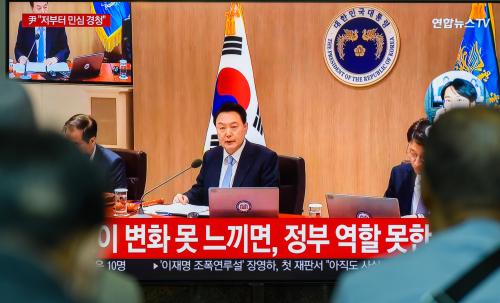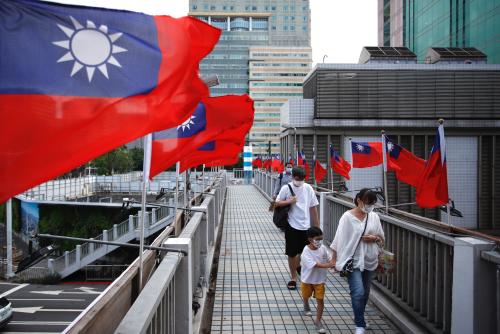The 40th anniversary of the fall of Saigon, and also of the end of the Second Vietnam War, on April 30, 1975 is an opportune time to look back at the international politics of Southeast Asia in the 1970s. This perspective can be instructive when observing the dynamics of the region today.
April 30 is a major milestone for the principal protagonists of the war. For the overseas Vietnamese community, it is the fortieth “Black April.” For the Vietnamese communists, it is obviously a celebratory occasion. For the Americans it can be a time for renewed introspection, such as the debate generated by the recent documentary Last Days in Vietnam directed by Rory Kennedy and commissioned by PBS.
Generally, the narratives and arguments from all communities are told from the inside out. This essay will instead focus on the reaction to the fall of Saigon from outside the conflict: the greater Southeast Asian dimension which has been much neglected in the “story” despite the fact that the vision of falling dominoes in Southeast Asia was one key reason for American involvement Vietnam, at least in the early years. Whatever one’s view of the Domino Theory (which remains controversial to this day), there is no doubt that the non-communist Southeast Asian states welcomed (and some may argue, exploited) the American involvement, and contributed to the American war effort in different ways. Thus, the fall of Saigon must have had an impact on these countries.
Indeed, April 30, 1975 was a watershed in the international politics of Southeast Asia. Singapore’s Prime Minister Lee Kuan Yew fully concurred with Secretary of State Henry Kissinger that if Washington had kept the right to bomb North Vietnam and there had been no Watergate, the North Vietnamese communists would not have launched their military offensive in 1974. As Lee put it, “there was no inevitability it (Saigon) would fall,” but as events proceeded his immediate reaction was “one of astonishment and alarm at the rapidity with which the situation fell apart.” The Indonesians too were surprised not so much by the fall of Saigon but more by the speed and completeness of the defeat. The Filipino leadership was also shocked by the U.S. inaction in the face of the collapse of South Vietnam; Ferdinand Marcos was sympathetic toward Nixon and felt that Nixon’s troubles were brought about by a hostile press and Congress, which he also saw as being unfriendly to himself.
As he often did during his career, Lee Kuan Yew shared his analysis with the American president, telling Gerald Ford in early May that the Thais were accusing the United States of having no morals, the Malaysians were frightened, and Marcos was reacting to the mass media. The good thing, Lee said, was that the Indonesians were “digging their toes in.” He was most prescient in his analysis of the immediate consequences of the fall. According to Lee, Hanoi might see this military success as a moment of destiny and might seek a master-servant situation with Cambodia and Laos and also exert pressure on the Thais. He noted that Vietnam had a well-trained and -equipped million-man army. While Bangkok was not in immediate danger, there was the urgent need to “calm the Thais down.” Laos, on the hand, was “a goner.” Cambodia would be the arena of a struggle between Beijing and Hanoi. Beijing would do its best to see that Hanoi did not control Cambodia. Moscow would support Hanoi. Referring to Vietnam, Lee said, “This is an Asian Yugoslavia. It’s Albania in reverse. The Soviet Union is backing the Titoists who are independently minded people.”[1]
Other ASEAN capitals were also assessing the implications of the fall. There was a general consensus that there was no immediate worry that Hanoi, “fully occupied with absorbing what they have already conquered,” would do more than exert control on Laos. But it was envisaged that the Vietnamese communists would step up their subversive activities in Thailand and Malaysia the following year. The communist insurgents in Thailand and Malaysia were “creatures in their own rights” but the Vietnamese communists’ triumph over the United States was seen as inspiring to them. To ensure that the Vietnamese success would not be emulated by their other Southeast Asian comrades, regional actors felt that the United States could not afford to be protectionist and needed to provide Thailand and Malaysia with counter-insurgency assistance. At the same time, the ASEAN countries needed to get their own act together. The inaugural summit meeting of ASEAN Heads of State was finally convened in Bali (23-24 February 1976) one year shy of the organization’s tenth anniversary. The fall of Saigon spurred them to action.
In 1975, some Southeast Asian leaders for the first time began to openly question the assumptions behind the Domino Theory. On May 6, 1975, Malaysian Foreign Minister Tan Sri Mohammad Ghazali Shafie delivered a scathing critique of the Domino Theory. Though the Vietnamese communists’ victory might inspire Malaysian insurgents, Ghazali Shafie dismissed the Domino Theory as “patently suspect in terms of both theory and empirical validity” and that “in practical empirical terms” it had no relevance to the states of Southeast Asia. One can understand why he came out so strongly against the theory at this time. This was a time to allay fears and anxieties and to prevent a self-fulfilling prophecy. Embedded in Ghazali Shafie’s presentation was one paragraph where he conceded that in an earlier time (not specified), various Southeast Asian states did subscribe to the theory after all.[2]
The ASEAN countries had not expected Washington to continue the war indefinitely; it was the manner of its final disengagement from South Vietnam in April 1975 that troubled them. Indeed, since 1969, ASEAN states had been making plans for an eventual American withdrawal from the region. In Malaysia’s post-Nixon Doctrine assessment, probably the most pessimistic of all the ASEAN states, U.S. withdrawal from Southeast Asia would be virtually completed by 1975. This would explain Kuala Lumpur’s Zone of Peace, Freedom and Neutrality (ZOPFAN) proposal (which was never fully supported by the other ASEAN members) and why it started the process of establishing diplomatic relations with China.
The end of the conflict in Vietnam and the perceived withdrawal of the United States from the region caused a number of Southeast Asian nations to accelerate engagement with China. Malaysia became the first Southeast Asian country to establish formal relations with the People’s Republic of China, in 1974, followed quickly by Thailand and the Philippines in 1975.
A delegation led by Anand Panyarachun, the Thai ambassador to the United States, travelled to Beijing in June 1975 to discuss diplomatic recognition. On July 1, 1975, during Prime Minister Kukrit’s visit to Beijing, Thailand established diplomatic relations with China. Three main reasons factored in the Thai decision to normalize relations with Beijing at this time: (a) Fear of a unified communist Vietnam and its influence in Laos and connection with the Khmer Rouge in Cambodia. The Thai leadership hoped that Beijing could help counter the potential threat from Hanoi. (b) Internal security. Bangkok hoped that Beijing could be induced to reduce if not end its support of the communist insurgencies in Thailand. (c) Potential economic benefits.
In a 23 September 1975 conversation between Philippines Foreign Secretary Carlos Romulo and Henry Kissinger, Romulo told Kissinger that the Marcos administration understood fully the U.S. position following the recent developments in Vietnam. “You had to do what you had to do,” he said. He informed Kissinger that President Marcos “had no illusions” and felt that it was time to establish relations with Beijing. Romulo also revealed that he and the Thai Foreign Minister had agreed on phasing out SEATO “without any discussion of the Manila Pact.”[3]
Even Ne Win of “neutral” Burma, who initially adopted a nonchalant attitude when Saigon fell, paid an unpublicized visit to Beijing in November 1975 and both sides reiterated the principles of peaceful co-existence and non-interference.
Jakarta, on the other hand, wanted American assistance in the modernization of the Indonesian armed forces so that Indonesia, the largest country in Southeast Asia, could play a bigger security role in the region. Suharto paid an informal visit to the United States on July 5, 1975 to discuss U.S. commitment and interest in Southeast Asia, and more specifically in Indonesia, a conversation that began during Suharto’s first visit to Washington in 1970. There was much discussion on the role of ASEAN, strengthening the defenses of ASEAN countries and ensuring the United States continued to play a supportive role in the region. Most importantly, the Indonesians were pleased to hear that the United States considered Indonesia one of the principal countries in Asia and main centre of power in Southeast Asia. President Ford subsequently visited Indonesia in December 1975. A few hours after his departure from Jakarta, Indonesia invaded East Timor, a subject which must be left to recount on another occasion.
Forty years later, almost all the key players at the time of the fall of Saigon have left the stage and many other significant events have shaped the course of Southeast Asian international politics. But beneath the surface, at least one thing has remained unchanged: the desire for the United States to remain engaged in the region and to play a prime role in the regional balance of power on the one hand, and, on the other hand, the need to engage China. Indeed at the end of the day, the rush to normalize ties with Beijing was triggered by the perception that with the United States withdrawal, non-communist Southeast Asia had lost a critical countervailing force and bulwark against the threat of communism.
[1] Memorandum of Conversation, 8 May 1975, The White House, “Memoranda of Conversations – Ford Administration”, Box 11, National Security Adviser, Memoranda of Conversations, 1973-1977, Gerald R. Ford Library.
[2] “On the Domino Theory” (RTM Broadcast, 6 May 1975) in M. Ghazali Shafie, Malaysia: International Relations – Selected Speeches (Kuala Lumpur: Creative Enterprise Sendiran Berhad, 1982, pp. 233-240.
[3] Memorandum of Conversation, 23 September 1975, DNSA, Kissinger Transcripts, KT01790.


Commentary
Op-edThe fall of Saigon: Southeast Asian perspectives
April 21, 2015